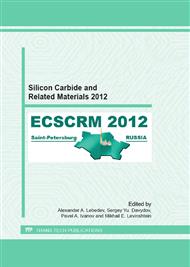p.699
p.703
p.707
p.711
p.715
p.719
p.723
p.727
p.733
Effects of a Post-Oxidation Annealing in Nitrous Oxide on the Morphological and Electrical Properties of SiO2/4H-SiC Interfaces
Abstract:
This work reports on the morphological, structural and electrical effects of a nitrous oxide (N2O) ambient post-oxidation annealing (POA) of the SiO2/4H-SiC interface. In particular, a conventional electrical characterization of MOS capacitors showed that nitrous oxide POA reduces the presence of both fixed oxide charge and the density of interface states. A local atomically flat interface was observed by transmission electron microscopy with only a moderate step bunching observed at a macroscopic scale. A novel nanoscale characterization approach via scanning spreading resistance microscopy resolved local electrical changes induced at the SiC surface exposed to N2O POA. This result subsequently revealed additional insight into the mechanism for the improved device performance subjected to N2O POA treatment.
Info:
Periodical:
Pages:
715-718
Citation:
Online since:
January 2013
Price:
Сopyright:
© 2013 Trans Tech Publications Ltd. All Rights Reserved
Share:
Citation:


